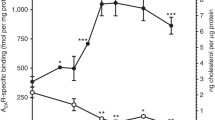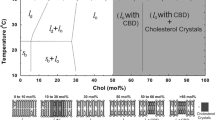Abstract.
Cholesterol influences many of the biophysical properties of membranes and is nonrandomly distributed between cellular organelles, subdomains of membranes, and leaflets of the membrane bilayer. In combination with the high dynamics of cholesterol distribution, this offers many possibilities for regulation of membrane-embedded receptors. Depending on the receptor, cholesterol can have a strong influence on the affinity state, on the binding capacity, and on signal transduction. Most important, cholesterol may stabilize receptors in defined conformations related to their biological functions. This may occur by direct molecular interaction between cholesterol and receptors. In this review, we discuss the functional dependence of the nicotinic acetylcholine receptor as well as different G protein-coupled receptors on the presence of cholesterol.
Similar content being viewed by others
Author information
Authors and Affiliations
Additional information
Received 31 March 2000; accepted 4 May 2000
Rights and permissions
About this article
Cite this article
Burger, K., Gimpl, G. & Fahrenholz, F. Regulation of receptor function by cholesterol. CMLS, Cell. Mol. Life Sci. 57, 1577–1592 (2000). https://doi.org/10.1007/PL00000643
Issue Date:
DOI: https://doi.org/10.1007/PL00000643




